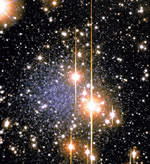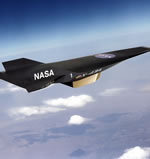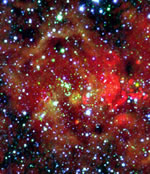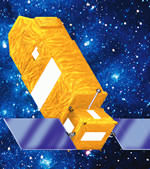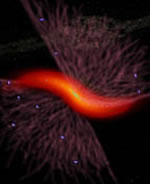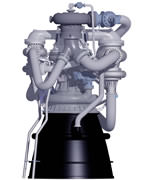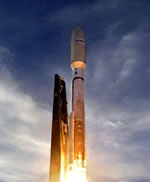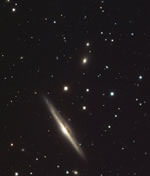
Image credit: SDSS
Since the discovery several years ago of a mysterious force, called dark energy, which seems to be accelerating the Universe, astronomers have been searching for additional evidence to either support or discount this theory. Astronomers from the Sloan Digital Sky Survey have found fluctuations in cosmic background radiation that match the repulsive influence of dark energy.
Scientists from the Sloan Digital Sky Survey announced the discovery of independent physical evidence for the existence of dark energy.
The researchers found an imprint of dark energy by correlating millions of galaxies in the Sloan Digital Sky Survey (SDSS) and cosmic microwave background temperature maps from NASA’s Wilkinson Microwave Anisotropy Probe (WMAP). The researchers found dark energy’s “shadow” on the ancient cosmic radiation, a relic of cooled radiation from the Big Bang.
With the combination of results from these two large sky surveys, this discovery provides physical evidence for the existence of dark energy; a result that complements earlier work on the acceleration of the universe as measured from distant supernovae. Observations from the Balloon Observations of Millimetric Extragalactic Radiation and Geophysics (BOOMERANG) of Cosmic Microwave Background (CMB) were also part of the earlier findings.
Dark energy, a major component of the universe and one of the greatest conundrums in science, is gravitationally repulsive rather than attractive. This causes the universe’s expansion to accelerate, in contrast to the attraction of ordinary (and dark) matter, which would make it decelerate.
“In a flat universe the effect we’re observing only occurs if you have a universe with dark energy,” explained lead researcher Dr. Ryan Scranton of the University of Pittsburgh’s Physics and Astronomy department. “If the universe was just composed of matter and still flat, this effect wouldn’t exist.”
“As photons from the cosmic microwave background (CMB) travel to us from 380,000 years after the Big Bang, they can experience a number of physical processes, including the Integrated Sachs-Wolfe effect. This effect is an imprint or shadow of dark energy on microwaves. The effect also measures the changes in temperature of cosmic microwave background due to the effects of gravity on the energy of photons”, added Scranton.
The discovery is “a physical detection of dark energy, and highly complementary to other detections of dark energy” added Dr. Bob Nichol, an SDSS collaborator and associate professor of physics at Carnegie Mellon University in Pittsburgh. Nichol likened the Integrated Sachs-Wolfe effect to looking at a person standing in front of a sunny window: “You just see their outline and can recognize them from just this information. Likewise the signal we see has the right outline (or shadow) that we’d expect for dark energy,” said Nichol.
“In particular the color of the signal is the same as the color of the cosmic microwave background, proving it is cosmological in origin and not some annoying contamination,” added Nichol.
“This work provides physical confirmation that one needs dark energy to simultaneously explain both the CMB and SDSS data, independent of the supernovae work. Such cross-checks are vital in science,” added Jim Gunn, Project Scientist of the SDSS and Professor of Astronomy at Princeton University.
Dr. Andrew Connolly of the University of Pittsburgh explained that photons streaming from the cosmic microwave background pass through many concentrations of galaxies and dark matter. As they fall into a gravitational well they gain energy (just like a ball rolling down a hill). As they come out they lose energy (again like a ball rolling up a hill). Photographic images of the microwaves become more blue (i.e. more energetic) as they fall in toward these supercluster concentrations and then become more red (i.e. less energetic) as they climb away from them.
“In a universe consisting mostly of normal matter one would expect that the net effect of the red and blue shifts would cancel. However in recent years we are finding that most of the stuff in our universe is abnormal in that it is gravitationally repulsive rather than gravitationally attractive,” explained Albert Stebbins, a scientist at the NASA/Fermilab Astrophysics Center Fermi National Accelerator Laboratory, an SDSS collaborating institution. “This abnormal stuff we call dark energy.”
SDSS collaborator Connolly said if the depth of the gravitational well decreases while the photon travels through it then the photon would exit with slightly more energy. “If this were true then we would expect to see that the cosmic microwave background temperature is slightly hotter in regions with more galaxies. This is exactly what we found.”
Stebbins added that the net energy change expected from a single concentration of mass is less than one part in a million and researchers had to look at a large number of galaxies before they could expect to see the effect. He said that the results confirm that dark energy exists in relatively small mass concentrations: only 100 million light years across where the previously observed effects dark energy were on a scale of 10 billion light years across. A unique aspect of the SDSS data is its ability to accurately measure the distances to all galaxies from photographic analysis of their photometric redshifts. “Therefore, we can watch the imprint of this effect on the CMB grow as a function of the age of the universe,” Connolly said. “Eventually we might be able to determine the nature of the dark energy from measurements like these, though that is a bit in the future.”
“To make the conclusion that dark energy exists we only have to assume that the universe is not curved. After the Wilkinson Microwave Anisotropy Probe results came in (in February, 2003), that’s a well-accepted assumption,” Scranton explained. “This is extremely exciting. We didn’t know if we could get a signal so we spent a lot of time testing the data against contamination from our galaxy or other sources. Having the results come out as strongly as they did was extremely satisfying.”
The discoveries were made in 3,400 square degrees of the sky surveyed by the SDSS.
“This combination of space-based microwave and ground-based optical data gave us this new window into the properties of dark energy,” said David Spergel, a Princeton University cosmologist and a member of the WMAP science team. “By combining WMAP and SDSS data, Scranton and his collaborators have shown that dark energy, whatever it is, is something that is not attracted by gravity even on the large scales probed by the Sloan Digital Sky Survey.
“This is an important hint for physicists trying to understand the mysterious dark energy,” Spergel added.
In addition to principal investigators Scranton, Connolly, Nichol and Stebbins, Istavan Szapudi of the University of Hawaii contributed to the research. Others involved in the analysis include Niayesh Afshordi of Princeton University, Max Tegmark of the University of Pennsylvania and Daniel Eisenstein of the University of Arizona.
ABOUT THE SLOAN DIGITAL SKY SURVEY (SDSS)
The Sloan Digital Sky Survey (sdss.org) will map in detail one-quarter of the entire sky, determining the positions and absolute brightness of 100 million celestial objects. It will also measure the distances to more than a million galaxies and quasars. The Astrophysical Research Consortium (ARC) operates Apache Point Observatory, site of the SDSS telescopes.
SDSS is a joint project of The University of Chicago, Fermilab, the Institute for Advanced Study, the Japan Participation Group, The Johns Hopkins University, the Los Alamos National Laboratory, the Max-Planck-Institute for Astronomy (MPIA), the Max-Planck-Institute for Astrophysics (MPA), New Mexico State University, University of Pittsburgh, Princeton University, the United States Naval Observatory, and the University of Washington.
Funding for the project has been provided by the Alfred P. Sloan Foundation, the Participating Institutions, the National Aeronautics and Space Administration, the National Science Foundation, the U.S. Department of Energy, the Japanese Monbukagakusho and the Max Planck Society.
The WILKINSON MICROWAVE ANISOTROPY PROBE (WMAP) is a NASA mission built in partnership with Princeton University and the Goddard Space Flight Center to measure the temperature of the cosmic background radiation, the remnant heat from the Big Bang. The WMAP mission reveals conditions as they existed in the early universe by measuring the properties of the cosmic microwave background radiation over the full sky. (http://map.gsfc.nasa.gov)
Original Source: SDSS News Release
